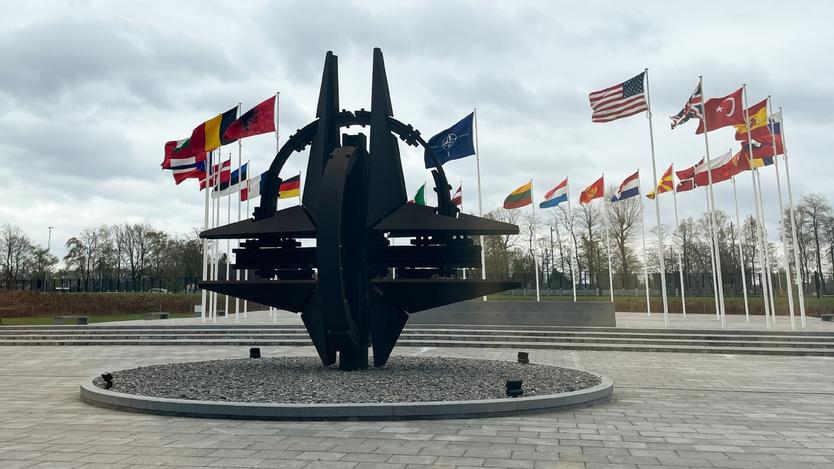 Photo taken on April 6, 2022 shows a sculpture and flags at NATO headquarters in Brussels, Belgium. (PHOTO / XINHUA)
Photo taken on April 6, 2022 shows a sculpture and flags at NATO headquarters in Brussels, Belgium. (PHOTO / XINHUA)
Russia said the involvement of NATO’s non-Arctic states in the bloc’s military activity in the region is worrying, and noted the risk of unintentional clashes with the alliance’s forces in the Arctic.
“The internationalization of the alliance’s military activities in high latitudes, in which non-Arctic NATO states are involved, can’t fail to cause concern,” said Nikolay Korchunov, the Russian Foreign Ministry’s ambassador-at-large for Arctic cooperation.
NATO’s military exercises in the north of Norway do not help to ensure security in the Arctic,
Korchunov said. “Recently, another large-scale military exercise of the alliance took place in the north of Norway, which, in our opinion, does not contribute to ensuring security in the region.
“This raises the risk of unintentional incidents, which, in addition to security risks, can also cause serious damage to the fragile Arctic ecosystem,” he said.
Earlier, media reports said that Finland and Sweden could apply for NATO membership as early as the coming summer.
Korchunov, who is also chairman of the Senior Officials Committee of the Arctic Council, said that if Sweden and Finland join NATO, this would harm security and trust in the Arctic region.
NATO’s expansion will not contribute to security and mutual trust in the Arctic, the strengthening of which Russia has consistently advocated, the diplomat said.
Meanwhile, the Russian Defense Ministry said on April 17 that Russian forces had struck a military plant outside Kyiv, as Moscow intensified its attacks on the Ukrainian capital.
In recent days, Russia has carried out several attacks on military plants in and around Kyiv after its Black Sea Fleet’s flagship Moskva sank after alleged attacks by Ukrainian Neptune missiles.
Photographs posted online on April 18 appeared to show the flagship on fire before sinking.
Two low-resolution photos taken from different angles showed a large warship — apparently the Moskva — engulfed in smoke and keeling over in open waters.
Few details about what happened to the Moskva have been disclosed since it sank off the Ukrainian coast, and the images — if authentic — were the first photos or videos to emerge of the stricken vessel, a 186-meter-long missile cruiser that was leading Russia’s naval effort in the “special military operation” on Ukraine.
While Russia claims its naval flagship sank during efforts to tow it to safety following an ammunition fire, Ukrainian military officials have said it was struck by Neptune missiles fired from Ukraine.
On April 19, Russia launched a major military operation in eastern Ukraine, opening a new phase of its campaign.
“We can now confirm that Russian troops have begun the battle for the Donbass, which they have been preparing for a long time,” Ukrainian President Volodymyr Zelensky said on the Telegram app late on April 18.
Ahead of the widely anticipated advance, Ukrainian authorities had urged people in Donbass to flee west to escape.
Russia’s intensified move on the Donbass came as much of the world’s attention was focused on the besieged southern city of Mariupol, where vastly outnumbered Ukrainian troops were holding out against Russian forces.
Amid the shift in Russia’s military focus, the Ukrainian presidential office said on April 18 that Zelensky had given the head of the European Union delegation in Kyiv a completed questionnaire that paves the way for Ukraine to gain the status of candidate for EU membership.
In other battlefield developments on April 18, Russia’s Defense Ministry said it had hit 16 military targets across Ukraine.
Among the sites struck was a depot near the western city of Lviv that Moscow said held weapons recently delivered from the US and Europe.


